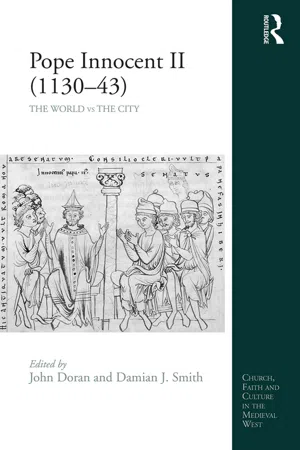7 Codex Udalrici, 425–7 no. 246. at 426; Pont. Rom. vitae, ii, 179–82, at 180. This letter is valuable evidence that the disabitato was then within easy reach of the abitato. Cf. M. Armellini, Le Chiese di Roma dal Secolo IV al XIX, nuova edizione… a cura di C. Cecchelli (Rome, 1942), 627–9, esp. 628, for the drawing by the ‘Anonimo Fabriczy’, which shows the rural character of the fortified monastery in the sixteenth century. The pro-Anacletus account, later sent by ‘the whole clergy and people of the Urbs Romana’ to Archbishop Diego Gelmírez of Compostela,8 spoke of ‘the disturbed state of the city, torn apart by hatred and enmity and the bitter agitation of the clergy’. In this febrile atmosphere of rumour and suspicion, the assembled cardinals and bishops – having decided, pro necessitate et tempore, to set aside the sententia canonum which stated that no action should be taken about the election of a new pope before the death and burial of the current one – appointed a committee of eight of their number to whom they entrusted the election. But when some of the cardinals (including Peter Pierleone and a supporter, Jonathan, cardinal deacon of SS. Cosma e Damiano9) were sent to take charge of the fortifications of S. Adriano, where the election was to be held, they were, according to the ‘clergy and people’, prevented by ‘some bishops who inclined to the other side’, and, suspecting bad faith, ‘the pars maior et sanior did not dare to return to the said monastery’.10 Thus, only six members of the committee were present when Honorius II died on the night of 13–14 February. Having hastily buried the pope in a temporary grave, five of the six, joined by the other cardinals in S. Gregorio, elected Gregory, cardinal deacon of S. Angelo and archdeacon of the Roman Church, as Innocent II, against the protest (as the Anacletans alleged) of Peter of Pisa, cardinal priest of S. Susanna, the sixth member of the electoral committee.11 The Pierleoni party, led by the aged Peter, cardinal bishop of Porto,12 and supported by a multitude of Roman clergy and citizens, then gathered in the church of S. Marco, where Peter Pier-leone was chosen, three hours after Innocent II, and consecrated in St Peter’s nine days later (23 February), as Anacletus II.13
8 De obitu,?16 April 1130, the whole clergy and people of the Urbs Romana to Abp Diego Gelmírez of Compostela: Historia Compostellana, ed. E. Falque Rey, CCCM, 70 (Turnhout, 1988), i, 455–8 (Pont. Rom. vitae, ii, 187–90). 9 Brixius, 36 no. 25. He was rewarded with Anacletus’s former title of S. Callisto. 10 De obitu, 456–7 (Pont. Rom. vitae, ii, 187–8). A. Molien, ‘Conclave’, Dictionnaire de Droit Canonique, 7 vols (Paris, 1924–65), iii, 319–48; P. Jugie, ‘Conclave’, The Papacy, i, 392–4; P. Herde, ‘Die Entwick-lung der Papstwahl im 13. Jahrhundert’, Österreichisches Archiv für Kirchenrecht, 32 (1981), 11–41. 11 CP of S. Susanna: Brixius, 38–9 no. 37; Zenker, 103–4. 12 Brixius, 37–8 no. 22; Zenker, 25–6. 13 For the propagandist material, see Palumbo and Schmale, above, n. 1. Whether or not the precise circumstances were as reported by the Anacletans, Cardinals Peter Pierleone and Jonathan withdrew from a process which would almost certainly have resulted in Gregory’s election, since the electoral committee was split five to three in Gregory’s favour.14
14 Robinson, Papacy, 74. The members are listed in Bp Hubert of Lucca’s reply to Abp Norbert of Magdeburg: Pont. Rom. vitae, ii, 179–82, at 180. For Gregory/Innocent: CBs: William of Palestrina (Praeneste) and Conrad of Sabina; CP: Peter Rufus of SS. Martino e Silvestro; CDs: Gregory of S. Angelo (Innocent II) and Aimeric of S. Maria Nuova. For Peter/Anacletus: CPs: Peter Pierleone of S. Callisto (Anacletus) and Peter Pisanus of S. Susanna; CD: Jonathan of SS. Cosma e Damiano. Historians have attempted to explain the crisis in terms of deep fissures among the cardinals, between Romans and non-Romans, or between northerners and southerners, or the older generation and the younger – particularly between those appointed by Paschal II and the Honorius II intake. Professor Robinson, in line with recent scholarship, expertly dismisses or modifies nearly all of these explanations, except the division based broadly on generation, and on the intervention of the two leading families, the Pierleoni15 and the Frangipani,16 which fed on and exacerbated the volatility of the broader Roman population.17 Each family dominated segments of the city (Pierleoni: the Isola Tiburina and the ancient theatre of Marcellus, which is still commemorated in the Lungotevere Pierleoni; Frangipani: the region around the Colosseum, including the Palatine and Coelian hills) and competed for power and status as much in the City as in the papal administration. In 1124, the Frangipani had played a major role in the election of Honorius II, but in 1130, the Pierleoni had one of their own sons in the college of cardinals, while the Frangipani favoured the election of someone in the mould of Honorius. There is no doubt that the Pierleoni deployed financial and strategic power in sustaining Anacletus, just as the Frangipani used theirs to support Innocent. Since neither pope conceded, and their electors remained loyal, there ensued an eight year struggle for the allegiance of the wider Church.
15 M. Thumser, Rom und der römische Adel in der späten Stauferzeit (Tübingen, 1995), 181–4; M. Stroll, The Jewish Pope. Ideology and Politics in the Papal Schism of 1130 (Leiden, 1987), 10–20. 16 M. Thumser, ‘Die Frangipane. Abriß der Geschichte einer Adelsfamilie im hochmittelalterlichen Rom’, QF, 71 (1991), 106–63. 17 Robinson, Papacy, 68–73. 